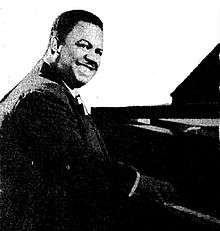Meade Lux Lewis
| Meade Lux Lewis | |
|---|---|
 Lewis in a 1944 advertisement | |
| Background information | |
| Birth name | Meade Anderson Lewis |
| Born |
September 1905 Louisville, Kentucky, U.S. |
| Died |
(aged 58) Minneapolis, Minnesota, U.S. |
| Genres | Boogie-woogie, piano blues |
| Occupation(s) | Musician |
| Instruments | Piano |
| Years active | 1920s–1964 |
| Labels | Paramount, Parlophone, Blue Note |
Meade "Lux" Lewis (born Meade Anderson Lewis; September 1905 – June 7, 1964) was an American pianist and composer, noted for his work in the boogie-woogie style. His best-known work, "Honky Tonk Train Blues", has been recorded by many artists.
Biography
Lewis was born in Louisville, Kentucky[1] in September 1905 (September 3, 4 and 13 have all been cited as his date of birth in various sources). In his youth he was influenced by the pianist Jimmy Yancey.[2] His father, a guitarist who made two recordings of his own, introduced Meade to music and arranged for violin lessons. He gave up the violin at age 16, shortly after his father's death, and switched to the piano. The nickname "Lux" was given to him by his boyhood friends. He would imitate a couple of characters from a popular comic strip in Chicago, Alphonse and Gaston, and stroke an imaginary beard as part of the routine. His friends started calling him the Duke of Luxembourg because of this, and the name stuck for the rest of his life. He became friends with Albert Ammons during childhood, a friendship that would last throughout their lives. They went to the same school together briefly and they practiced and learned the piano together on the Ammons family piano.[3]:90–91
A 1927 rendition of "Honky Tonk Train Blues" on the Paramount Records label marked his recording debut.[2] He remade it for Parlophone in 1935 and for Victor in 1937 and a recording exists of a Camel Caravan broadcast, including "Honky Tonk Train Blues" from New York City in 1939. His performance at John Hammond's historic From Spirituals to Swing concert at Carnegie Hall in 1938 brought Lewis to public attention.[4] Following the event, Lewis and two other performers from that concert, Albert Ammons and Pete Johnson, often appeared as a trio and became the leading boogie-woogie pianists of the day.[2][4]
They performed an extended engagement at Café Society, toured as a trio, and inspired the formation of Blue Note Records in 1939. Their success led to a decade-long boogie-woogie craze,[5] with big band swing treatments by Tommy Dorsey, Will Bradley, and others; and numerous country boogie and early rock and roll songs.
Lewis appeared in the movies New Orleans (1947) and Nightmare (1956).[2] He also appeared, uncredited, in the movie It's a Wonderful Life, playing piano in the scene where George Bailey gets thrown out of Nick's Bar.[6]
Lewis was quite fond of the Minneapolis area, where a niece lived, and would visit as often as he could. He appeared annually at the White House Restaurant (no longer extant) in Golden Valley. He began a successful three-week engagement there in May 1964. Around two a.m. the morning of Sunday, June 7, leaving the parking lot of the White House and heading east on Olson Memorial Highway, Lewis' Chrysler Imperial was rear-ended by one Ronald Bates, who was traveling an estimated 80 mph. Lewis' car was pushed 400 feet, impacting a tree and killing him instantly. He was 58. Bates survived, but his passenger died the following day.[3]:225
Legacy
Lewis' best-known work, "Honky Tonk Train Blues", has been recorded in various contexts, often in a big band arrangement.[2] Early recordings of the piece by artists other than Lewis include performances by Adrian Rollini, Frankie Trumbauer, classical harpsichordist Sylvia Marlowe, theater organist George Wright (with drummer Cozy Cole, under the title "Organ Boogie"), and Bob Zurke with Bob Crosby's orchestra. Keith Emerson of Emerson, Lake & Palmer often included it in his repertoire and had a Top 30 hit with it in 1976.
Lewis was mentioned in Chapter 81 of author Kurt Vonnegut's novel Cat's Cradle. Lewis is also mentioned in Ross Macdonald's novel The Moving Target and in Keith Richards's autobiography Life.
Discography
- 1941 – Boogie Woogie (compilation), Columbia Records, C44[7]
- 1975 – Tell Your Story, Oldie Blues, OL 2805
- 1982 – Giant of Blues and Boogie Woogie 1905–1964, Oldie Blues, OL 2810
- 1984 – Chicago Piano Blues and Boogie Woogie 1936–1951 Vol. 3, Oldie Blues, OL 2827
References
- ↑ "Meade Lux Lewis, Pianist, Is Killed". The New York Times. June 8, 1964. Retrieved October 2, 2015.
- 1 2 3 4 5 Russell, Tony (1997). The Blues – From Robert Johnson to Robert Cray. Dubai: Carlton Books Limited. p. 135. ISBN 1-85868-255-X.
- 1 2 Silvester, Peter J. (1989). A Left Hand Like God: A History of Boogie-Woogie Piano. Da Capo Press. ISBN 978-0306803598.
- 1 2 Yanow, Scott. "Meade Lux Lewis Biography". AllMusic. Rovi Corporation. Retrieved December 5, 2014.
- ↑ Palmer, Robert (1982). Deep Blues: A Musical and Cultural History of the Mississippi Delta. Penguin Books. p. 130. ISBN 978-0140062236.
- ↑ "Meade Lux Lewis on IMDb". Retrieved December 28, 2009.
- ↑ "Various – Boogie Woogie". Discogs. Retrieved 2015-12-13.
External links
- Meade Lux Lewis biography on African American Registry
- Meade Lux Lewis discography at Discogs
- Meade 'Lux' Lewis discography at Rate Your Music
- Meade Lux Lewis at the Internet Movie Database
|